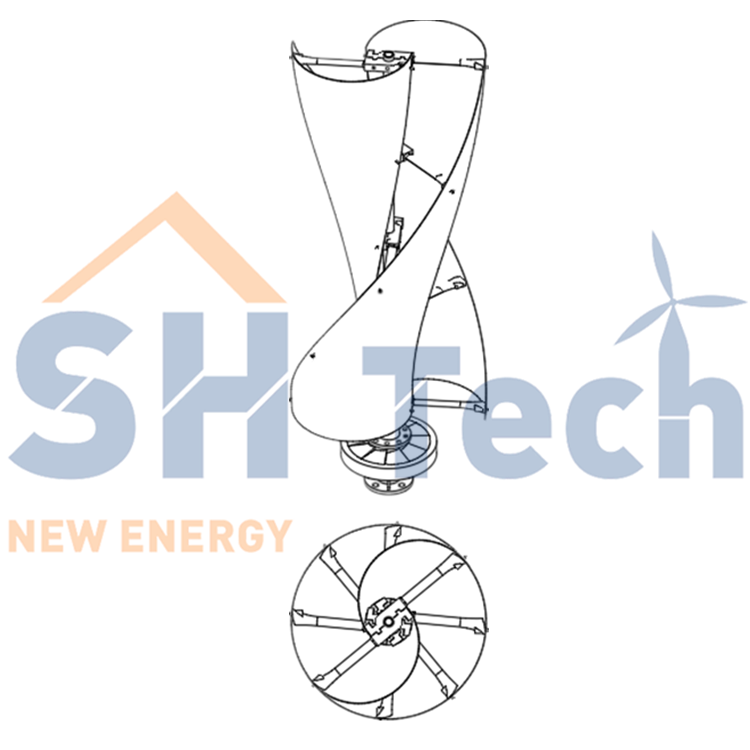We feature a lot of off-grid power projects here at Hackaday, whether they’re a micropower harvester or something to power a whole house. Somewhere in the middle lies [esposcar90]’s 3D-printed vertical wind turbine, which it is claimed can deliver 100 watts from its diminutive tabletop package.
It’s designed to be part of a package with another turbine but makes a very acceptable stand-alone generator. The arms have large scoop-like 3D-printed vanes and drive a vertical shaft up the centre of the machine. This drives a set of satellite gears connected to a pair of DC permanent magnet motors, which do the work of generating. For different wind situations, there are even some differing STL gear choices to speed up the motors. The motors are 12V devices, so we’re guessing the output voltage will be in that ballpark. However, it’s not made entirely clear in the write-up. 10kw Wind Turbine

All in all, it’s a very compact and practical off-grid power solution, given a place with enough wind and a requirement for 100W. We can imagine it might find use with hikers in mountainous regions or perhaps radio amateurs doing a SOTA activation. We like it.
If your tastes run to something larger, you can 3D print that, too. If you want a smaller demonstration and have a spare CDROM drive, this project can be very simple.
Missing a link to the project writeup!
I’m going to blame WordPress… yah…. WordPress, that’s it. Fixed.
100 watts from a tabletop wind turbine hunh? That would require hurricane force winds.
Kind of a pointless post without some specifics. Actual test results would be great, but a link to the design would be a good start.
Yeah, VAWTs have horrifically bad efficiency because they have to push half of their rotor into the wind. That 100W figure is pure nonsense.
100W, the size of the light bulb in your lounge if it is incandecent
The key piece of information missing was “when driven by a leaf blower”. The claim is really only about the max rating of the design, not the expected output in real conditions.
No, the correct phrase is “when driven on one side by a leaf blower”. It wouldn’t have spun nearly as fast if the upwind cups were also in the blower.
Neat idea, kind of analogous to a portable solar panel. It’d be cool if it could fold up into a cylinder shape. 100W is a bit optimistic but the good news is lots of things don’t need that much power. I like it!
There is absolutely no way that is generating 100W from such a small area.
I’d betz one can calculate the minimum wind speed needed for 100 W given the active area of the turbine.
Comes out to around 30-40 m/s depending on what assumptions you make. Equal to a Category 1 hurricane.
It comes out to a bold face lie because: the alternator would require 12-14ga wire, more than likely a Halbach array in the rotor, zero mechanical inefficiencies, considerably sturdier construction, and given the design, a customized, precision bearing and gearing system… basically BS pulled from a dead, non-funded Kickstarter campaign. Welcome to Hackaday 2023 awards. Next up: a rotting raccoon I pulled from the wastebin behind my house… an introduction to sustainability by feeding the biota in your backyard.
“I’ve built a wind generator, which can provide 1KW power!” (during lab conditions and wind provided by an F16’s exhaust…)
That rotor design is far from the most efficient.. and with a standard motor as generator, the losses in energy are simply too high.
Come on, HaD, you can do it [better]!
Vertical wind turbine is no sense… We know that from 100 years from Darius and Savonius tests results…
Put a wind turbine on ground is perfect in order to protect it from the wind…
It depends on what you do with it. Savonius rotors are the perfect solution to drive exhaust fans on vehicles and rooftops. No electricity needed and if built correctly, maintenance-free for decades.
Wind turbine/farm hacking and electronic devices insurance conversation with Allstate agent 9/221/23. https://prosefights2.org/irp2023/p092423/allen.mp3
12V motor means the motor was tested at 12V. Open circuit output voltage is a function of speed. DC motors don’t have a “voltage” just like a resistor doesn’t have a “voltage”.
No it means the motor is rated for 12 V when used as a motor. Resistors and motors both have maximum voltage ratings, for various reasons.
For resistors it is generally based on the separation distances.
For motors it will be based on the maximum allowable current. With a higher voltage the current will be higher, especially the stall current. So indirectly the maximum voltage is set by the thickness of the wire used for the motor windings. Also on brushed DC motors the voltage sets the maximum speed. Motors are mechanical too so have mechanical limitations, like rotational velocity limitations on the bearings and commutator and will also have voltage and current ratings for the commutator and brushes, again partly to do with separation distances. If the voltage applied to a brushed motor is too high, then the current drawn in various situations will be too high and the speed reached will be too high and cause excessive bearing heating and wear, it may damage he wires due to heat and it may damage the brushes.
Brushless motors have similar voltage and current ratings.
If motors didn’t have a voltage, like you say then motors wouldn’t burn out when you run them with too high of a voltage.
They’re claiming 100W… at 12V? So his alternator is wired with 12 or 14 ga wire to be rated for the Amps? Now look at the picture and tell me where that alternator fits… then realize that talking about the Voltage is pointless because this is a fraud taking advantage of most people’s ignorance regarding the finer points of wind power generation.
In addition to all the other comments rightly questioning the (unchallenged) 100W claim, I thought the overall physics of small wind turbines just didn’t stack up practically – winds are much slower & more disturbed at low altitudes and efficiency scales as (something like) the square of swept area, hence the drive to ever taller turbines with huge swept areas.
That’s why they need to be used differently and/or much much cheaper. Both are possible for a limited set of places and purposes, although past a certain point, solar might be better. The reason smaller can be cheaper is that while it’s not as efficient, it also doesn’t require good materials or a factory. Historically, people got by with poor efficiency from small windmills with lots of flat blades for pumping water long before anyone could build a modern wind turbine.
Please be kind and respectful to help make the comments section excellent. (Comment Policy)
This site uses Akismet to reduce spam. Learn how your comment data is processed.

Wind Turbine Power By using our website and services, you expressly agree to the placement of our performance, functionality and advertising cookies. Learn more